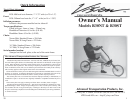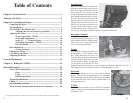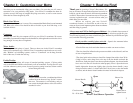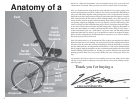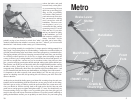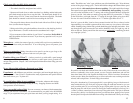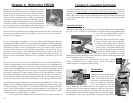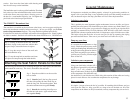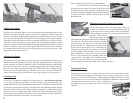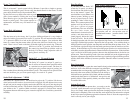
8
section. Now insert the front brake cable housing ends
into the cable stops on the handlebar.
The handlebar stem is at the top of the handlebar. The 6mm
bolt at the top of the main handlebar tube can be loosened
to allow the stem to move up or down, allowing you to set
the bars for a comfortable height for you. Re-tighten the
pinch bolt to the listed torque specification.
The VISION™ Recumbent Seat
The seat fabric is installed on the seat frame at the factory, and we suggest studying the
front strap attachment carefully before removing it. In case you forget, see the front
tension strap attachment diagram. This strap should be tightened periodically.
For the first few weeks, the seat fabric will stretch a bit and appear loose. Simply tighten
the fabric as needed - the fabric will stabilize after about 100 miles or so. Check the seat
Front Tension Strap Attachment
Step 1. Looking at the front of the seat, with the
seat fabric laying on the seat frame, take the thin
strap and loop it around the frame crosspiece.
Step 2. Loop the strap in front of the small stub
tube but behind the strap.
Step 3. Loop the strap back around the seat frame
crosspiece and strap through the ladder buckle.
Attaching the Seat Fabric Panels to the Seat
The following are instructions for installing the upper seat fabric panel; the other three
panels attach the same way. The view is from above the seat back.
Step 1. Drap the seat fabric over the seat side
rails as shown
Step 2. Stretch (hard!) the long flap toward
the short side pulling the inner short flap to-
ward the long side, and attach together. Rub
the entire attachment area together firmly.
Step 3. Stretch the remaining short flap over
the other two and attach. Again rub the entire
area together firmly.
Pinch bolt
Stem
Upper Handlebar
13
Photo ofPhoto of
Photo ofPhoto of
Photo of
enjoyenjoy
enjoyenjoy
enjoy
General Maintenance
It's important to maintain your Metro properly, to keep it in good running condition. A
regular visit to your bike shop is very important to keep your bike running smooth and
safe, but between trips to the shop your Metro will love some simple attention.
Lubricate your chain.
This is probably the most important regular maintenance item on any bike, and just as
probably the most ignored. You should lube your chain at least every month. More if you
ride a lot and do it every time you get rained on. Simply use an old rag to wipe the chain
and apply a commercial bicycle chain lubricant (NOT WD-40!) to the chain. After the
lube has had a chance to penetrate the links, it's important to wipe off all the excess lube.
This helps to keep the chain free of excess road grit. Do this by repeating the wiping
procedure outlined above. Take care of your chain and it will take care of you.
Pump up your tires.
It is normal for tire pressure to drop
slowly. Check the pressure every week
with a good hand pump. Inflate the tires
to the pressure rating printed on the tire
itself. Don't use pumps at gas stations...
you'll be sorry if you do, your tires might
blow off the rim.
Lubricate your components.
Using your chain lube, or better still, a
drip bottle of general bicycle lubricant
(NOT "3 in 1" oil), carefully apply
drops of lubricant to all the pivot points
of the components. Get the brakes and
the derailleur (if your bike has one) While doing this examine all the cables and casing
pieces for wear and tear. Also examine the components for any damage.
Know your bike.
It's simple—just get to know the feel of your bike. If something feels different, and you
can't figure out what it is, bring your bike to a shop to have it checked out. All of the
components on the Metro are bicycle standards, and any competent shop can service it.



